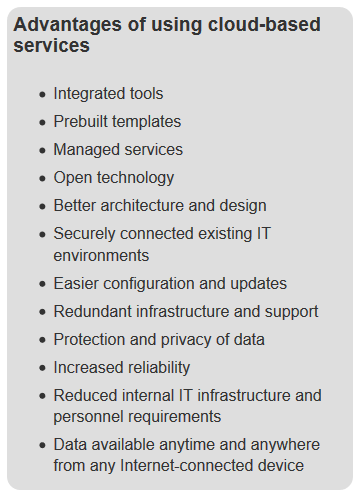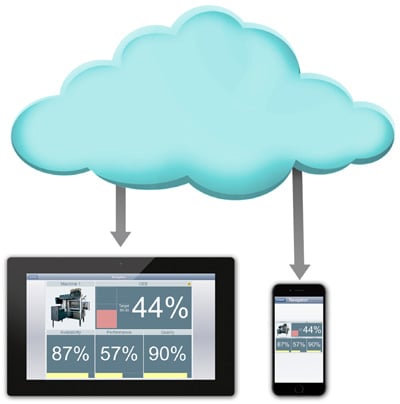This post was authored by Larry Combs, vice president of customer service and support at InduSoft, a supplier of HMI/SCADA software as a part of the Schneider Electric family.
Cloud-based human-machine interface (HMI) software, databases, and historians are ideal gateways to deliver practical and actionable machine, manufacturing, and plant information to those who need it. Harnessing cloud capabilities to harvest data from plant floor automation systems and then distributing this data to users is a powerful combination that can save money, speed implementation, enhance security, and provide other benefits.
Although many see the cloud as a mysterious entity, it is in fact widely used in applications such as webmail, Web commerce (eBay), music and video downloads, and social media. Like the storage and distribution of manufacturing data, these commercial applications involve secure storage and distribution of large amounts of data to multiple users. The main differences between commercial and manufacturing applications are the security and reliability required to safely store and distribute plant data.
Cloud types and hosting methods
There are many different types of cloud implementations, with selection based on application specifics. The first choice a prospective user must make is among a public, private, or hybrid cloud.
Public cloud infrastructure is available to the general public and owned by an organization selling cloud services. Private cloud infrastructure is operated solely for the company generating the data. It may be managed by the company or a third party, and it may exist on or off premise. Hybrid clouds are private and public clouds bound together by standardized or proprietary technology to enable data and application portability.
Once a cloud type is selected, the next issue is deciding on a hosting method. As previously mentioned, the data storage and distribution software can be an HMI/supervisory control and data acquisition package, database, or historian. The data storage and distribution software can either run in the cloud or run locally and serve data to the cloud. In a cloud-based application, the data storage and distribution software runs entirely in the cloud and remotely connects to the plant automation network via the Internet.
In a local application, the data storage and distribution software runs on site in the plant and is directly connected to the plant automation network via the Internet. It pushes data to the cloud for distribution (figure 1).
 Figure 1. Accessing manufacturing data via the cloud can be a better solution than using internal IT infrastructure.
Figure 1. Accessing manufacturing data via the cloud can be a better solution than using internal IT infrastructure.
Whether running the data storage and distribution software in the cloud or locally, a company must select a cloud service provider. Cloud providers are typically broken down into three categories:
- infrastructure as a service (IaaS)
- platform as a service (PaaS)
- software as a service (SaaS)
IaaS providers, such as Amazon Web Services, represent the most mature and widespread service model used by HMI applications. They allow companies to deploy and run off-the-shelf HMI software just like they would on their own information technology (IT) infrastructure. IaaS provides on-demand provisioning of virtual servers, storage, networks, and other fundamental computing resources, allowing a company to pay for only as much capacity as it needs and to bring more online when required. The company does not manage or control the underlying cloud infrastructure, but has control over operating systems, storage, deployed applications, and select networking components (e.g., host firewalls).
PaaS providers, like Microsoft’s Azure or Google Apps, have a suite of software and product development tools hosted on their infrastructure, allowing developers to create applications over the Internet. The company consuming this type of service does not manage or control the underlying cloud infrastructure, but has control over the deployed applications and the application hosting environment configurations. PaaS is a common approach for consumers who develop their own HMI software and desire a common off-the-shelf development and run-time platform.
SaaS, such as Web-based email, lets a company use a provider’s applications running on a cloud infrastructure from various client devices through a thin-client interface such as a Web browser. Companies do not manage or control the underlying cloud infrastructure, but instead pay a fee to use the application.
Cloud benefits
Whatever the type of cloud or the category of service, storing and distributing data via the cloud has a number of benefits (see table). Cloud providers typically offer integrated tools through a simple and intuitive Web-based user interface. IT and operational technology (OT) staff no longer need to source and learn disparate and often incompatible tools. Instead, the provider can integrate the tools and all cloud resources into a common console that allows everything from creating and managing resources to viewing usage and billing. Most also offer mobile apps for use on the go.

Cloud providers offer prebuilt templates to simplify deployment of new resources like virtual servers, storage, and applications. Templates are optimized for specific workloads and applications and include the operating system, database software, and other required software. This eliminates the IT and OT staff time normally required to manually install and configure the software. It is also possible to create custom templates with all the software required for the HMI application. Using templates, new cloud resources can be running in minutes.
Cloud providers not only deliver infrastructure and applications, they also provide the managed services necessary to keep them running efficiently. Especially for smaller businesses, it can be difficult and expensive to maintain an in-house IT organization. Inadequate internal resources can compromise quality and security. Cloud providers can maintain specialists for networking, security, privacy, and other areas of high interest and concern. The result is a virtual IT department, dedicated to meeting specific needs cost effectively.
Cloud applications and interfaces are built on open technologies such as Java, HTML5, and RESTful Web services. Users and developers can access cloud resources using standard, well-known interfaces. Open technologies like OpenStack, CloudStack, and Eucalyptus are also available for creating a private cloud-computing platform. Commercial cloud providers often use these technologies, allowing seamless hybrid clouds.
Secure and scalable
Using cloud services for data storage and distribution improves data safety, security, and reliability. Cloud hosting also minimizes the on-site IT infrastructure and personnel—the cloud service provider handles hardware and software purchases, maintenance, upgrades, and access.
Cloud-computing structures tend to be more uniform than those of most traditional computing architectures, which are often patched together in a piecemeal process. This more homogenous architecture improves security by better delivery and implementation of configuration control, security audits, vulnerability testing, and more. Updates and patches are distributed in real time without any user intervention.
In a traditional IT infrastructure environment, a complete system collapse can occur if both the primary and single backup server fail at the same time. If a single cloud-computing node fails in a cloud-based system, other nodes take over those functions without any interruption.
Being able to easily switch back to a previous configuration lets developers make changes without having to start from scratch. If a problem occurs when deploying a patch or update, the developer can simply switch back to the previous configuration.
Distributing cloud data
Remote access to the cloud is available worldwide from any device capable of connecting to the Internet, including PCs, smartphones, and tablets. This access lets users monitor and analyze information loaded in the data storage and distribution software.
Cloud-computing providers have multiple, redundant Internet connections. If a company chooses to implement its own IT infrastructure, access to user data generally depends on the company’s single Internet provider. If the provider experiences an outage, users lose remote access to the HMI application.
Data maintained within a cloud is easily accessible, faster to restore, and often more reliable. On-demand resource capacity can ensure resilience when facing increased service demands or distributed denial-of-service attacks, as well as quicker recovery from serious incidents.
It is vitally important not to expose critical control infrastructure to the Internet. Using push technology to move data to the cloud, rather than pull technology, helps avoid such exposure. Push technology leaves no open network ports on the control infrastructure. Using a hybrid cloud with a virtual private network connection to the control infrastructure is also recommended.
Empowering mobile workers
Many cloud and mobility applications are used in remotely distributed control and monitoring applications. Water and wastewater, oil and gas, and renewable energy industries are common users of this technology.
By using mobility and the functionality it enables, monitoring and controlling local automation, instrumentation, and field devices can be enabled through the HMI from mobile devices (figure 2). Data from the HMI is pushed to the cloud, and most mobile devices, such as smartphones or tablets, can visualize it via the cloud.
 Figure 2. Cloud data provides mobility and actionable data to remote workers.
Figure 2. Cloud data provides mobility and actionable data to remote workers.
The cloud becomes the centralized data historian, which a broad range of personnel can access. These remote individuals can access production and other data no matter where they are. If they are local and internal to a plant or a facility, the cloud does not need to play a role, as Wi-Fi can provide better performance, remaining in service should the cloud or the connection to it fail.
Another application is a supplier maintaining its equipment or systems installed on site. Data can be sent to the cloud, and the supplier can monitor the information for remote support and service, even extending to predictive maintenance.
Control system integrators can offer cloud-based monitoring as a service, setting up the entire system and selling cloud-based monitoring on an as-needed basis to customers. For example, a firm may need to evaluate oil well information for just a month, making it easier for it to engage an integrator to set up cloud-based remote monitoring, rather than doing the same thing internally.
HMI, cloud, and mobile device technologies are available for industrial use and are a good fit for many mobile access applications. Using the cloud for access to HMI data via mobile devices is often a better alternative than purchasing, implementing, and maintaining internal computing infrastructure. Users can start slowly with one HMI application, and then expand to others as the technologies become familiar and proven in use.
About the Author
Larry Combs uses his more than 30 years of customer service, professional service, and technical sales and management experience to sustain a world-class client service organization supporting the Wonderware InduSoft Web Studio product family. Before joining InduSoft, Combs was vice president of customer success at Cesura. He also led worldwide field technical services operations at Dazel, a Hewlett-Packard Software company. Combs has a B.S. in computer science, math, and system design from the University of Texas at San Antonio.
A version of this article also was published at InTech magazine.



